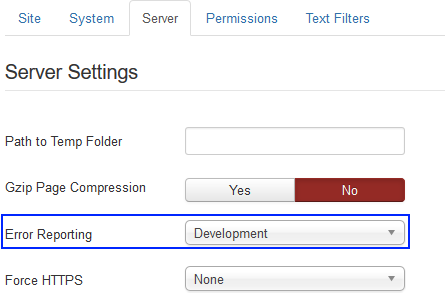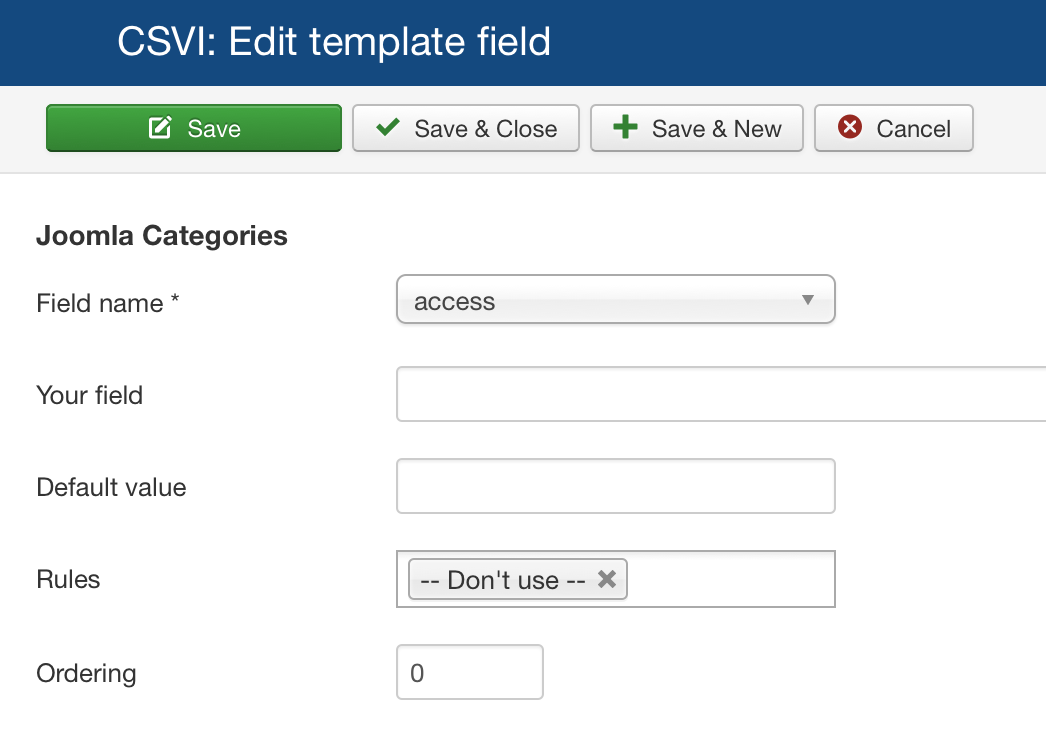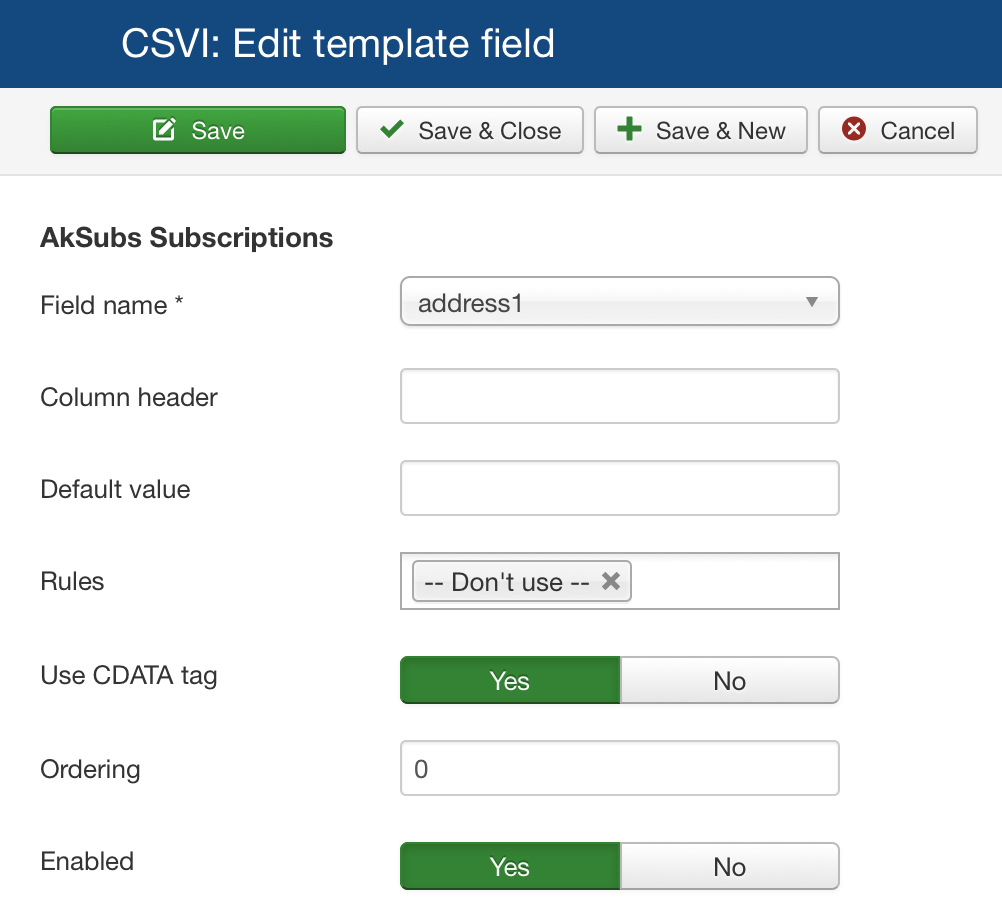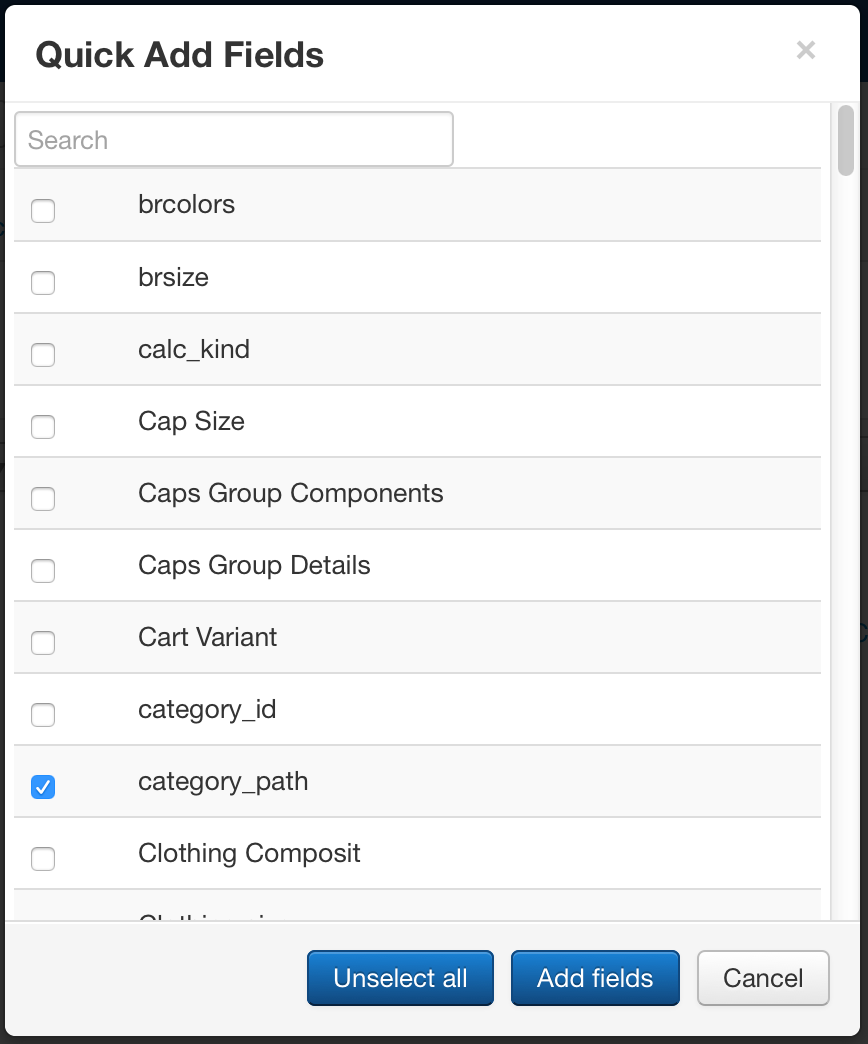RO CSVI
Removing HTML tags on export
| RO CSVI
The removal of HTML tags on export is a question that is quite simple to do with CSVI using the Replacement feature.
Requirements:
- CSVI 7 or higher
Steps to remove HTML tags:
- Go to Components -> CSVI
- Click on Rules in the left menu
- Click on New
- Fill in a name for the replacement rule
- Select the Action
- Select the plugin CSVI Multireplace
- Click on Save to store the settings and load the rule
- Now select the Operation Find and replace
- Fill in Find with /<[\/\!]*?[^<>]*?>/i
- Leave Replace empty
- Set Multiple values to No
- Set Method to Regular expression
- Optionally set an order
- Click on Save & Close
- Go to Template fields
- Select the template where you want to apply the replacement rule to
- Click on the fieldname where the rule needs to be applied to
- Now under Rules select the rule you created
- Click on Save & Close to save the changes
- You will see a wand behind the fieldname indicating that a rule has been applied
- Run the export on your export template and you will see that the exported file will have no HTML in the chosen field
Getting started with RO CSVI
| RO CSVI
Before you start with RO CSVI it is good to know which goal you are trying to achieve. RO CSVI is a tool that has a multitude of possibilities but the basics are to import or export data.
Whether you are doing an import or an export the first step is to create a template. A template can be created in 2 different ways:
- Via Templates -> Templates
- Via Templates -> Field Mapper
Add-ons
RO CSVI can be used with a multitude of Joomla! extensions. Support for these extensions is shipped separately and as such need to be installed separately. The different add-ons can be downloaded from the Download page and then choose RO CSVI Extensions. You can download the extension you wish to use RO CSVI for from here and install it as a regular Joomla! extension.
Updating available fields
After RO CSVI and the necessary addons are installed it is a good idea to update the list of available fields. These fields are needed for making the import and export run, otherwise it might happen you end up with missing fields. Follow the steps in the Missing fields in CSVI document to make sure everything is up-to-date.
Steps to run an import or export
- Create a template
- Edit the options in the template
- Add the fields you wish to use to the template
- Run your import or export
Templates
How to create a template is explained in the Create a template tutorial.
Template fields
After a template is created fields will need to be added to the template so CSVI knows which fields to use for import/export. How to add template fields is explained in the Adding template fields tutorial.
Field Mapper
The field mapper is a tool to help you setup the basic template and the fields belonging to the template. The fieldmapper is explained in the CSVI Field Mapper tutorial.
Troubleshooting
If you have problems importing your file, have a look at the Troubleshooting import errors document.
If you have problems exporting your file, have a look at the Troubleshooting export errors document.
500 Internal Server Error
| RO CSVI
The Internal Server Error is probably the worst error you can get. The error means that the server is telling you something went wrong but not what has gone wrong. It is now up to you to find out what has gone wrong.
Kown causes
There are a number of known causes and easy fixes:
- Folder and or files do not have the correct privileges
- Solution: Set the correct privileges for the folders and files
Folders should have permission 755
Files should have permission 644
- Solution: Set the correct privileges for the folders and files
- Missing folders and or files
- Solution: Re-install necessary packages and/or patches
- Trying to resize images that are too large
- Solution:
- Make sure your large images are not too large
- Create your own thumbnails
- Set the maximum size of the large image RO CSVI should create a thumbnail for
- Solution:
- Old PHP version
- Solution: Check that the PHP version used is at least 7.4 but recommended is PHP 8.0 or higher
- BOM in your file
- Solution: Set the Auto-detect delimiters to No in your template and specify them manually in the template.
- Export of SEF URLs
- Solution: When exporting SEF URLs it can be a huge strain on the server. Instead of generating SEF URLs during export you can pre-fetch the SEF URLs by going to Maintenance -> Select your extension -> Refresh SEF URLs. This will populate the database with the generated SEF URLs and the export will read them from the database instead of requesting them from the server. Make sure you have set the Domain name in the RO CSVI Settings.
- Incompatible addon versions
- Solution: Check that RO CSVI and the addons are all the same version. Enable the option Check addon version in the RO CSVI Settings
Error reporting
In some cases the 500 Internal Server Error can be changed to a visible error by setting the Error Reporting to Development as explained in the steps below.
- Go to System -> Global Configuration
- Click on the Server tab
- Set Error Reporting to Development

- Click on Save & Close
Once the Error Reporting is set to Development, run the import again and see if you get the real error. If not, you will have to check the Server error log section.
Server error log
The real error is in the server error log. This may not be a log you have access to, so contacting the hosting provider is advised in that case. Explain to them the situation and that you would like to know which error has been generated by the server. With the real error in hand it should be easy to fix the issue. If you need help, post the real error in the forum and we will gladly assist you.
Error building Admin Menus
| RO CSVI
This is an issue caused by Joomla and the only way to fix this is to manually clean up your system. To clean up your system take the following steps:
- Delete all references in the jos_extensions table where element is com_csvi. Replace jos with your own prefix. Find them with this command:
SELECT * FROM `jos_extensions` WHERE element="com_csvi"
- Delete all references in the jos_assets table where name is com_csvi. Replace jos with your own prefix. Find them with this command:
SELECT * FROM `jos_assets` WHERE name="com_csvi"
- Delete all references in the jos_menu table where title is like com_csvi. Replace jos with your own prefix. Find them with this command:
SELECT * FROM `jos_menu` WHERE title LIKE "COM_CSVI%"
- Now install CSVI again as outlined in the Install CSVI in 5 steps tutorial.
Adding tempate fields
| RO CSVI
Required fields
- A template has already been created as explained in the Create a template tutorial
Template fields are needed by CSVI to know which fields you want to import/export.
To start adding fields to your template go to Templates -> Template fields and you will see:

There are 2 ways to add fields:
- Use the New button
- Quick Add button
New button
After clicking the New button you will get a new screen to add your field. The screen you will see depends on your template.
Import field
An import template will show this screen:

Import fields
- Field name
Select the field that CSVI knows. A full list of fields can be found on the Available Fields page. - Your field
CSVWhen using CSV files with fields you want to combine, set the Field name to combine and in Your field enter the name of the field in your CSV file.XMLEnter the full XML node path where the data is to be found. Unsure which path to use, use the Analyzer to see how CSVI reads your XML file. - Default value
Enter a default value.This value will be used when the field in the import file is empty. - Rules
Choose the rules to apply to the field. - Ordering
Enter the order the field should be in.
An export template will show this screen:

Export fields
- Field name
Select the field that CSVI knows. A full list of fields can be found on the Available Fields page. - Column header
Enter a custom column header. This header will be used instead of the field name. - Default value
Enter a default value. This value will be used if the export finds no value in the database. - Rules
Choose the rules to apply to the field. - Use CDATA tag
Only used for XML. Set this to yes if your field requires CDATA tags in the XML output file. - Ordering
Enter the order the field should be in. - Enabled
Set if the field should be exported. If you are combining fields, set this to No to prevent this field from being added to the export file. The field will still be used for the rule operations.
After you have filled in all the fields click on one of the Save buttons to store the field. You can add as many fields as you need.
Quick Add
The Quick Add button can be used to quickly add multiple fields to your template.

You can select one ore more fields form the list and then click the Add fields button. At first only the Cancel button is visible, the other buttons will appear as soon as a field is selected. The search box at the top will filter the list of fields, this will help to locate fields faster when you have a long list. Previous selected fields will not be lost, they are just hidden while you search.
If you want to edit one of the fields after they have been added, you can either click on the field name or on tick the box and click on the Edit button in the toolbar.